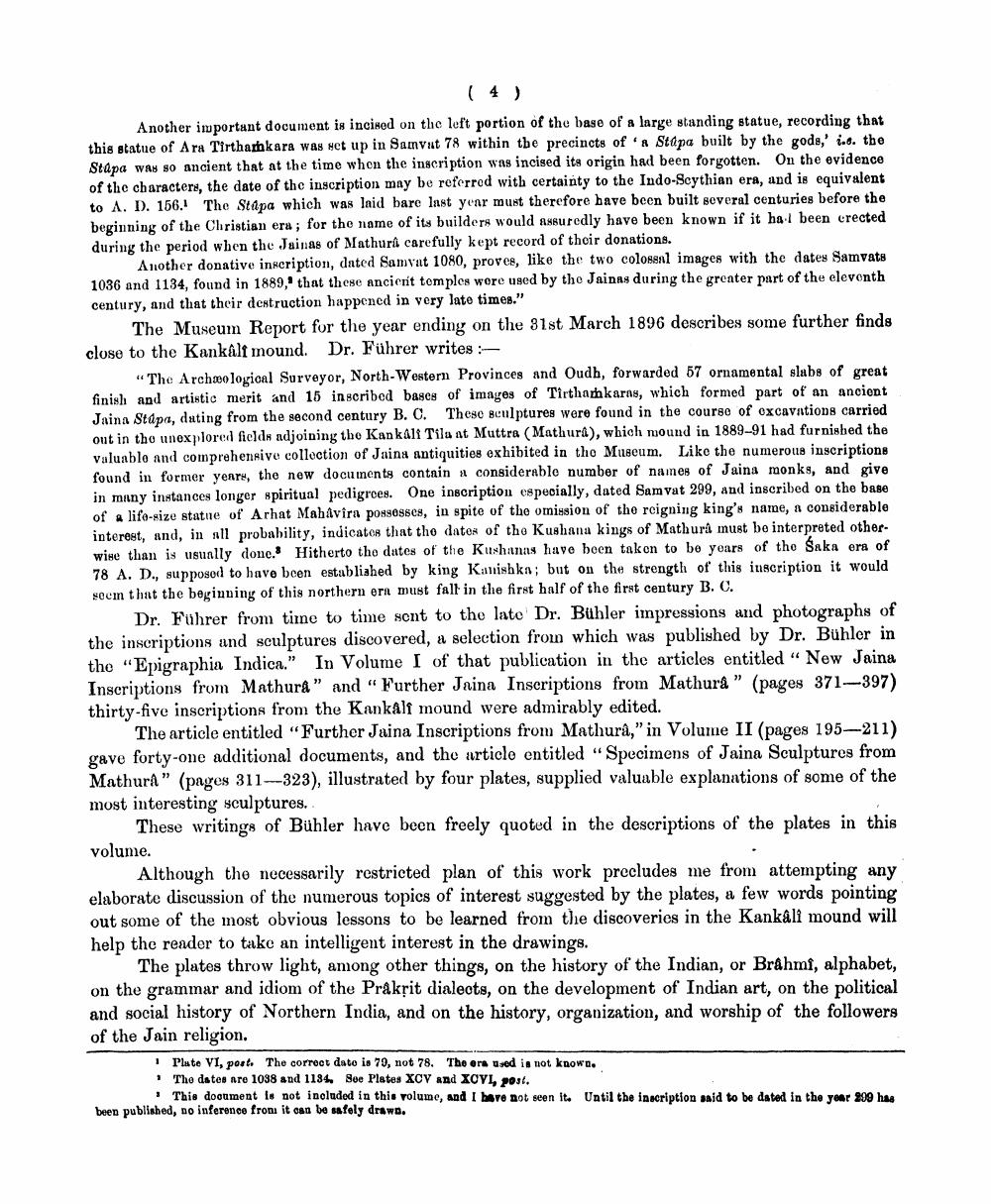________________
Another important document is incined on the left portion of the base of a large standing statue, recording that this statue of Ara Tirthamkara was set up in Samvut 78 within the precincts of a Stepa built by the gods,' i.. the Stapa way so ancient that at the time when the inscription was incised its origin had been forgotten. On the evidence of the characters, the date of the inscription may be referred with certainty to the Indo-Scythian era, and is equivalent to A. D. 156. The Stapa which was laid bare last year must therefore have been built soveral centuries before the beginning of the Christian era ; for the name of its builders would assuredly have been known if it had been crected during the period when the Jainas of Mathuri carefully kept record of their donations.
A110ther donative inscription, dated Samvat 1080, proves, like the two colossal images with the dates Samvats 1036 and 1134, found in 1889," that these ancient temples were used by the Jainas during the greater part of the eleventh century, and that their destruction happened in very late times."
The Museum Report for the year ending on the 31st March 1896 describes some further finds close to the Kankalf mound. Dr. Führer writes -
The Archeological Surveyor, North-Western Provinces and Oudh, forwarded 57 ornamental slabs of great finish and artistic merit and 15 inscribed bases of images of Tirthamkarns, which formed part of an ancient Jaina Stapa, duting from the second century B. C. These sculptures were found in the course of excavations carried out in tho unexplored ficids adjoining the Kankali Tila at Muttra (Mathura), which mound in 1889-91 had furnished the Valuable and comprehensive collection of Jaina antiquities exhibited in the Museum. Like the numerous inscriptions found in former years, the new documents contain a considerable number of names of Jaina monks, and give in many instances longer spiritual pedigrees. One inscription especially, dated Samvat 299, and inscribed on the base of a life-size statue of Arhat Mahavira possesses, in spite of the omission of the reigning king's name, a considerable interest, and, in all probability, indicates that the dates of the Kushana kings of Mathurd must be interpreted otherwise than is usunlly done. Hitherto the dates of the Kushanas have been taken to be years of the Saka era of 78 A. D., supposod to have been established by king Kanishka; but on the strength of this inscription it would soom that the beginning of this northern era must fall in the first half of the first century B. C.
Dr. Führer from time to time sent to the late Dr. Bühler impressions and photographs of the inscriptions and sculptures discovered, a selection from which was published by Dr. Bühler in the "Epigraphia Indica." In Volume I of that publication in the articles entitled "New Jaina Inscriptions from Mathura" and "Further Jaina Inscriptions from Mathura ” (pages 371-397) thirty-five inscriptions from the Kankalf mound were admirably edited.
The article entitled "Further Jaina Inscriptions from Mathura," in Volume II (pages 195-211) gave forty-one additional documents, and tho article entitled "Specimens of Jaina Sculptures from Mathura" (pages 311-323), illustrated by four plates, supplied valuable explanations of some of the most interesting sculptures.
These writings of Bühler have been freely quoted in the descriptions of the plates in this volume.
Although the necessarily restricted plan of this work precludes me from attempting any elaborate discussion of the numerous topics of interest suggested by the plates, a few words pointing out some of the most obvious lessons to be learned from the discoveries in the Kankali mound will help the reader to take an intelligent interest in the drawings.
The plates throw light, among other things, on the history of the Indian, or Brahmi, alphabet, on the grammar and idiom of the Prakrit dialects, on the development of Indian art, on the political and social history of Northern India, and on the history, organization, and worship of the followers of the Jain religion.
1 Plate VI, port. The correct dato is 79, not 78. The ora used is not knowo. • Tho dates are 1038 and 1184. Soe Plates XCV and XOYI, post.
This document is not included in this volume, and I have not seen it. Until the inscription said to be dated in the year 200 has been published, no inference from it can be safely drawn.




